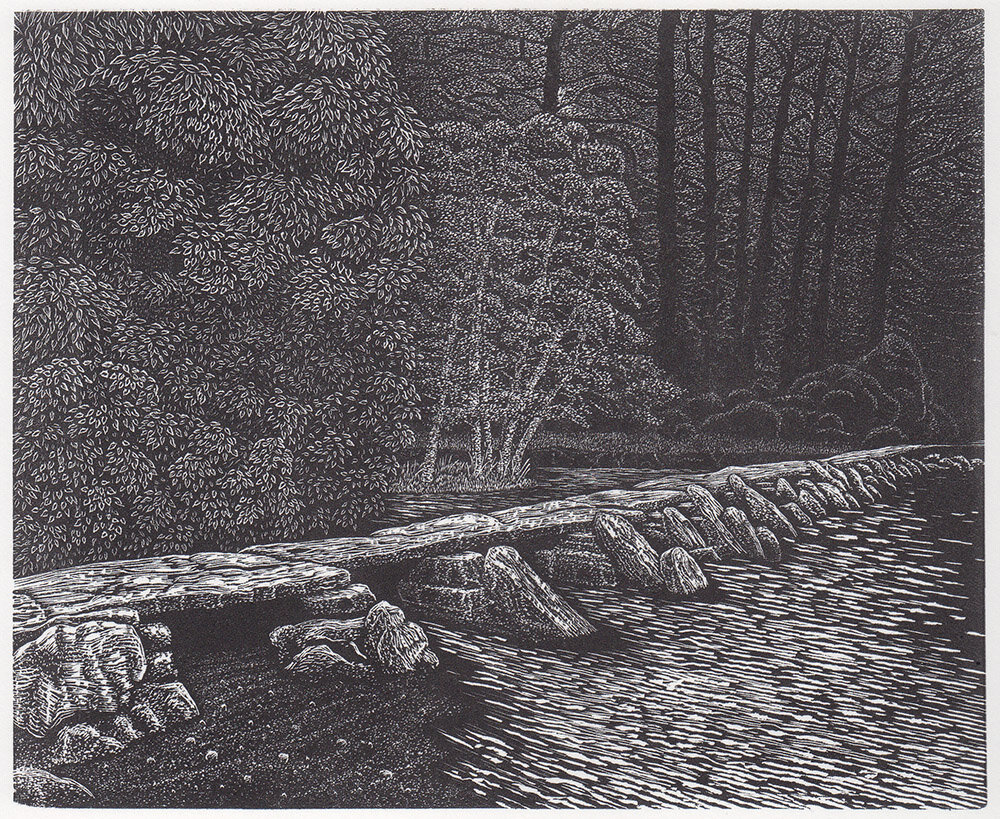 Image 1 of
Image 1 of


The Tarr Steps
14 x 17 cm
Wood engraving
Tarr Steps is a truly beautiful place. Sitting by the river you can imagine all the people thoughout history who have crossed here using this ancient bridge. The Tarr Steps is a clapper bridge across the River Barle in the Exmoor National Park. There is no confirmed date when the Tarr Steps were built. It might be as old as the Bronze Age although the commonly accepted date is in the medieval period. Its name “Tarr” gives us a clue to its age. The Celtic “Tochar” or “Toher” means “causeway” (across water).
Folklore has it that the bridge was laid by the devil. Tarr Steps is the largest example of a clapper bridge (derived from the Medieval Latin “claperius” meaning pile of stones). It spans fifty meters with stone slabs up to two and a half meters long weighing nearly two tonnes.
These prints are original wood engravings. I engrave on boxwood or lemon wood blocks using traditional hand tools. Then I ink up the block and print the edition one at a time. Each print is an original artist print.
No. of prints in edition: 60
This print is made using Lawrence Original Linseed Oil Relief Ink. The formulas used to create these inks have been in use for hundreds of years and are “free from animal-based or derived ingredients, made with linseed oil, not honey or gelatine”. The paper is archival and acid free.
Each print is signed, dated and editioned in pencil below the image.
14 x 17 cm
Wood engraving
Tarr Steps is a truly beautiful place. Sitting by the river you can imagine all the people thoughout history who have crossed here using this ancient bridge. The Tarr Steps is a clapper bridge across the River Barle in the Exmoor National Park. There is no confirmed date when the Tarr Steps were built. It might be as old as the Bronze Age although the commonly accepted date is in the medieval period. Its name “Tarr” gives us a clue to its age. The Celtic “Tochar” or “Toher” means “causeway” (across water).
Folklore has it that the bridge was laid by the devil. Tarr Steps is the largest example of a clapper bridge (derived from the Medieval Latin “claperius” meaning pile of stones). It spans fifty meters with stone slabs up to two and a half meters long weighing nearly two tonnes.
These prints are original wood engravings. I engrave on boxwood or lemon wood blocks using traditional hand tools. Then I ink up the block and print the edition one at a time. Each print is an original artist print.
No. of prints in edition: 60
This print is made using Lawrence Original Linseed Oil Relief Ink. The formulas used to create these inks have been in use for hundreds of years and are “free from animal-based or derived ingredients, made with linseed oil, not honey or gelatine”. The paper is archival and acid free.
Each print is signed, dated and editioned in pencil below the image.
14 x 17 cm
Wood engraving
Tarr Steps is a truly beautiful place. Sitting by the river you can imagine all the people thoughout history who have crossed here using this ancient bridge. The Tarr Steps is a clapper bridge across the River Barle in the Exmoor National Park. There is no confirmed date when the Tarr Steps were built. It might be as old as the Bronze Age although the commonly accepted date is in the medieval period. Its name “Tarr” gives us a clue to its age. The Celtic “Tochar” or “Toher” means “causeway” (across water).
Folklore has it that the bridge was laid by the devil. Tarr Steps is the largest example of a clapper bridge (derived from the Medieval Latin “claperius” meaning pile of stones). It spans fifty meters with stone slabs up to two and a half meters long weighing nearly two tonnes.
These prints are original wood engravings. I engrave on boxwood or lemon wood blocks using traditional hand tools. Then I ink up the block and print the edition one at a time. Each print is an original artist print.
No. of prints in edition: 60
This print is made using Lawrence Original Linseed Oil Relief Ink. The formulas used to create these inks have been in use for hundreds of years and are “free from animal-based or derived ingredients, made with linseed oil, not honey or gelatine”. The paper is archival and acid free.
Each print is signed, dated and editioned in pencil below the image.